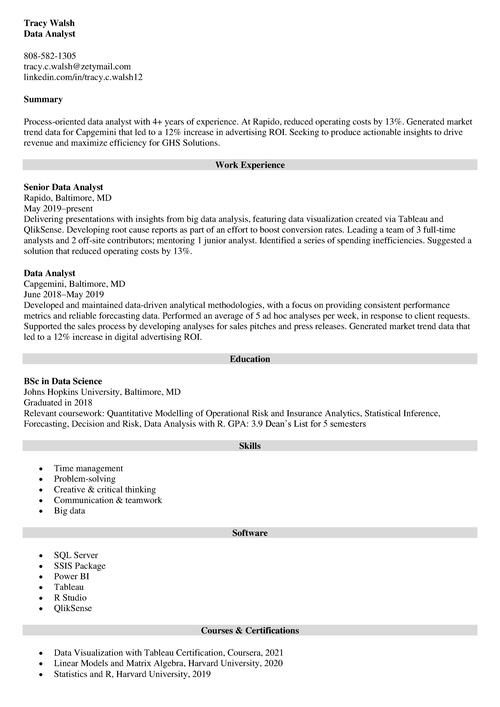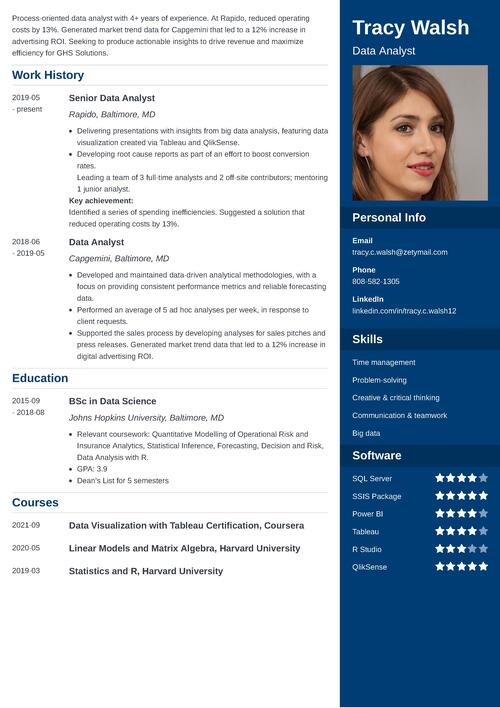
Resume Sections & Categories (with Tips on Order & Titles)
Are all resumes created equal? Which resume sections should you include if you're a professional with awards, skills, years of experience? Or someone with no experience, and not much to put on a resume?
You’d think they would be two very different resumes. But in reality, both resumes will have the same formal resume sections at their core.
With all the free online resume templates out there, should you make your resume
unique like a snowflake? Or use a proper set of typical resume sections? You’re about to find out!
That’s why this article will show you:
- What typical resume parts form the core for all resumes.
- Which resume "categories" to choose for your resume.
- How to put resume sections in order on a resume.
Want to save time and have your resume ready in 5 minutes? Try our resume builder. It’s fast and easy to use. Plus, you’ll get ready-made content to add with one click. See 20+ resume templates and create your resume here.
Sample resume made with our builder—See more resume examples here.
Looking for more guides and examples on writing your perfect resume? See:
- Things to Put on Resume
- Resume Headers
- Best Resume Format
- Part Time Job Resume
- Resume for First Job
- Resume Examples for 500+ Jobs
1
What Resume Sections Should a Standard Resume Include?
What sections should a standard resume include?
A standard resume should include five basic resume sections:
Mandatory Resume Sections (Standard Resume Categories)
- Contact Information
- Resume Summary or Resume Objective
- Work Experience Section
- Education Section
- Skills Section
Those parts of a resume above matter most.
But there are many more unique resume sections you can use to boost your resume.
That’s because you can split resume sections into two categories:
- Basic (Need to Have)
- Optional (Nice to Have)
Now that you know the five basic sections, what is the additional information you can put on your resume?
Optional Resume Sections (Additional Resume Categories)
- Awards and Honors
- Volunteer Work
- Certifications and Licenses
- Projects
- Hobbies and interests
- Qualifications
- Extracurricular Activities
- Accomplishments
- Associations
- Publications
- Languages
- Training
- Conferences
You can even break your resume skills section down into different categories:
- Personal Skills
- Management Skills
- Technical Skills
- Computer Skills
- Additional Skills
But how do you decide what resume sections to include on your resume? Here's a few examples to explain this:
| right |
|---|
Choose unique resume sections that best reflect the professional things you’ve done. |
| wrong |
|---|
Add every possible resume section to your resume - including the kitchen sink. |
Let’s say you’re a Project Manager with tons of projects under your belt. Plus you speak three languages and have won several awards.
Which additional resume sections should you include?
- Resume Project Section
- Resume Language Section
- Resume Awards Section
Don’t add resume categories if you can’t list at least a couple of things in each section.
Prioritize the unique resume sections you choose to add. Start by picking categories that are the most relevant and the most impressive.
For example, our Project Manager may have a ton of volunteer work that she’s done. But adding a resume volunteer section is not as relevant as projects, languages, and awards.
If you have room left over, you can always add more personal resume sections.
Just remember that the ideal length for a resume is one page with a two-page limit.
Pro Tip: There are some resume sections that you no longer need to put on a resume. One such section is the resume reference section. Hiring managers know they can ask you for references. You no longer need to put that information on your resume.
Too much hassle? Don't worry. He have a collection of pre-made resume templates that will save you a bunch of time: Best Resume Templates to Download
2
How to Order Resume Sections to Attract Hiring Managers
Deciding which sections of a resume to add is the easy part.
The tricky part is putting appropriate components of a resume together to best work for you.
See, the hiring manager is used to seeing resume sections appear in a certain order.
At the same time, the best order of items on your resume is one that draws attention to your strongest selling points.
So, the key is to strike a balance. Follow a traditional resume format but order resume sections to highlight your talents.
Order of Resume Sections for a Standard Resume
- Contact Information
- Resume Summary
- Experience
- Certifications (Optional)
- Education
- Skills
- Additional Sections
For regular job seekers with work experience, it’s best to lead with your experience.
If you’re occupation comes with a certification, it’s best to add it to your job title, the resume certification section, and potentially your education section as well.
Order of Resume Sections for College Students
- Contact Information
- Resume Objective
- Education
- Experience/Internships
- Extra Curricular Activities (Leadership Section)
- Skills
- Hobbies and Interests
As a student or entry-level candidate, your education is your strongest selling point. If you’ve had internships or any work experience, that should come second.
It’s also a good idea to add relevant extra curricular activities to your resume. And that's especially true if you held a leadership position.
Leadership is one of the first skills hiring managers look for in new graduates, according to our HR statistics report.
Why hobbies and interests?
Adding a resume interests section can show hiring managers that you’re a good cultural fit. Research the company’s culture and choose a few of your interests that reflect that culture.
Order of Resume Sections for a Professional Resume
- Contact Information
- Resume Summary
- Experience and Accomplishments
- Associations and Certifications (Optional)
- Education
- Skills
- Additional Sections
As a senior-level professional, all you have to do is spice up the standard order of things.
You’ve worked long enough to have achievements, so add them to your experience section. The big fishes also speak at conferences, publish, or join associations.
Don’t forget to add these things to your resume in the appropriate resume sections.
Order of Resume Sections for a Career Changer Resume
- Contact Information
- Resume Objective
- Relevant Experience
- Additional Experience (Optional)
- Education
- Skills
- Additional Sections
When you’re changing a career, there’s a chance not all your past jobs will match your new one. But if you held impressive roles, you’ll still want to add them to your resume.
That’s why you may want to consider splitting your resume experience section in two.
But let’s say you’re switching from Accountant to Chef.
You’ve never held a position in the gastronomic industry in the past. At the same time, you’ve completed training at Le Cordon Bleu.
Be sure to add this detail to your resume objective. Get rid of the additional experience section. Then put your relevant training closer to the top of your resume.
Pro Tip: The key to putting your resume sections in order is knowing your strengths. Hiring managers will look at the top third of your resume before reading more. That’s why you want to make sure that your most relevant and impressive qualifications are at the top.
Not sure how to add achievements or accomplishments to your experience section? We have a guide for that. Read our guide: “Achievements to Put on a Resume - Complete Guide (+30 Examples)”
3
Here’s What to Put in Resume Sections (Tips & Examples)
Okay, so you know what smart resume sections to put on a resume.
You know what order of resume sections will work best for you.
But now you’re probably wondering, “That’s great, but is a skills section really necessary on a resume? What should I put in the experience section of a resume anyway?”
Good questions. Let’s answer them.
Contact Information Resume Section
Every resume needs a “Contact Information” section.
All you need to include is your name, phone number, and email address.
You can also include, social media handles (for example LinkedIn), licenses, and links to your website or blog. Putting your address on your resume is no longer necessary.
| right | wrong |
|---|---|
| Name and Surmname | Nickname |
| Phone Number | Second Phone Number |
| Email Address | Your Current Work Email |
| Social Media Handles | Date of birth |
| Web Addresses | Marital Status |
| License Information | Race or Gender |
| Address (Optional) | Photo |
You do not need to add any information to your about me resume sections that may cause discrimination against you.
Also, it is not standard to include a photo on an American resume.
Pro Tip: You can slip degrees or license information into your email address. For example, [email protected]. It’s a clever way to add important information to your contact section without losing any space.
Want to know more about how to write a contact information section? Don’t know how to layout your contact information? Read our guide: “How to Include Contact Information on a Resume (Examples)”
Resume Summary and Resume Objective
Whether you’re a fresh graduate or an experienced professional, start your resume with a bang.
Include a resume summary, objective, or profile at the beginning of your resume.
How do you figure out which of these three resume sections is right for you?
The resume summary is great for professionals with achievements and skills.
That’s because a resume summary tells a hiring manager that you’re a professional with the skills to do the job. Add a couple of lines summary to highlight your best, most relevant skills.
| right |
|---|
Outgoing Bartender with 5+ years of experience working in fast-paced nightclub venues in major metropolitan areas. Increased sales by 25% at the Rabbit Hole Bar after introducing themed cocktails. Seeking to leverage customer service and sales skills for a position as Head Bartender at Billy Goat Bar. Have a Bartender Certification valid in most states. |
| wrong |
|---|
Motivated Accountant seeking a job and a promotion at Accountants For You Inc. |
Everyone else (entry-level candidates, students, career changers) should use the objective. It's basically a resume introduction section that tells a hiring manager who you are right now and what you want to become.
If you’re an IT professional, you may want to include a profile section. A profile is a bullet point list of your skills and knowledge that you must have to do the job. Such a list tells the hiring manager that you have everything they want right away.
Pro Tip: It’s important to tailor all your resume sections to the job offer. But if you’re only going to tailor one, let it be your resume summary. Add phrases and skills that you find in the job offer. That way the hiring manager sees what they want right away.
When making a resume in our builder, drag & drop bullet points, skills, and auto-fill the boring stuff. Spell check? Check. Start building a professional resume template here for free.
When you’re done, Zety’s resume builder will score your resume and tell you exactly how to make it better.
Want to find out how to write a resume summary or a resume objective that will knock the socks off recruiters? Read our guides: “20+ Resume Summary Examples for Multiple Jobs” and “20+ Resume Objective Example Statements”
Resume Experience Section
You could argue that your experience section is one of the most important compontents of a resume.
That’s why you should make sure that it is easy for both humans and robots to find.
So, instead of using an alternative resume section heading, stick with “Experience.”
Often, companies use Applicant Tracking Systems (ATS) software to scan resumes. Keeping your resume section titles simple helps the software read your resume.
Your experience section should include the relevant jobs you’ve held. List them in reverse-chronological order. Start with your most recent position.
List your title, dates worked, the name of the company, and its location.
Add up to six bullet points detailing both your duties and achievements. Don’t list every boring duty you ever had. Instead choose responsibilities that reflect skills you find in the job offer.
Add quantifiable achievements. Adding accomplishments proves that when you execute a responsibility you get results.
| right |
|---|
Marketing Manager (March 2014 - Present) Ostrich Feather Marketing, Dayton, OH
|
| wrong |
|---|
Marketing Manager (March 2014 - Present) Ostrich Feather Marketing, Dayton, OH
Responsible for managing marketing professionals and graphic designers. Responsible for creative marketing campaigns for large corporate clients. Responsible for creating video, online, and digital marketing campaigns. Responsible for developing internal marketing strategies for employee engagement. |
Whatever you do, do not start each bullet point in your experience resume section with the words “responsible for.” Use action verbs instead. The hiring manager will pay more attention and get a better idea of what you can do.
Pro Tip: It’s okay to namedrop in your professional resume sections. If you’ve done work for large, well-known clients, name them. The only exception to the rule is if your clients were private.
Want to know more about how to write a resume experience section? Want to find out how to use bullet points to take your work experience section to the next level? Read our guide: Resume Bullet Points to Make a *Killer* Resume Job Description
Resume Education Section
Like your experience section, title your education “Education.”
You’ll want to include all your education to date, starting with your highest degree first.
List all your other degrees in reverse-chronological order. If you finished college, don’t add your high school information.
What to include:
- Type of Degree
- Your Major/Minor
- Name of School
- School’s Location
- Year Graduated (or Anticipated Graduation Date)
- Relevant Coursework (optional)
Don’t add your GPA unless it was above a 3.5.
| right |
|---|
Harvard University, Cambridge, MA MA in English Literature Graduated in 2009 with a 3.7 GPA |
| wrong |
|---|
Cherryville High School, Cherryville, OH Graduated in 2005
Harvard University, Cambridge, MA MA in English Literature Graduated in 2009 with a 3.7 GPA |
Like most resume sections, you can format your education section in various ways.
If you went to a more prestigious university like Harvard, lead with the name of the school. If your degree is more impressive, lead with that instead.
Remember to put your highest degree first.
Pro Tip: You can add unfinished degrees to your resume. You paid for those credits, so they’re yours. The formatting will be a bit different. Write: Completed 45 credits toward a degree in Biology. Put this under the name of the school and the dates you attended.
Still not sure how to add your resume education section to your resume? Want to see how to put certification courses on a resume? Read our guide: “How to Put Your Education on a Resume [Tips & Examples]”
Resume Certifications Section
Are you a professional with licenses or certifications? In that case, you may want to add a resume certification section.
This is one of those resume sections where you can combine things. So, you may want to title the section only “Certifications." Otherwise, you may want to add licenses and use the title, “Licenses and Certifications.”
What to include:
- Name of Certification
- Name of Certifying Body or Agency
- Date Certified
- Location (If Applicable)
| right |
|---|
Project Management Professional (PMP) Certification, Project Management Institute, 2013 |
| wrong |
|---|
PMP Certification |
Be sure to write out acronyms at least once. Even if all you find in the job offer is acronyms for certifications. Don’t list every certification you have on your resume.
If you’re a Project Manager, your PMP certification is important and relevant. Your CPR certification is not.
Pro Tip: You can also place your license or certifications in your contact information section. You can even stick it next to your name. For example, Douglas Fisher, PMP.
Want to know more about how to list certifications on a resume? Want to see a list of online certifications that will help boost your career? Read our guide: “How to List Certifications on a Resume: Guide +20 Examples”
Resume Skills Section
Is a skills section necessary on a resume?
Yes, skills should be one of your resume sections.
One of the top things a hiring manager looks for when they scan your resume is skills they listed in the job offer.
That’s why providing them with a list that matches what they asked for puts you on a path to getting the job. How do you know what skills to list? Read the job offer then include the ones you have and are present in the job ad.
| right | wrong |
|---|---|
Speak and write in fluent Spanish. | Spanish |
Proficient in Microsoft Office including Excel and Powerpoint. | Microsoft Office |
Working knowledge of WordPress. | WordPress |
Able to manage and implement Social Media campaigns. | Social Media Marketing |
Excellent written and verbal communication skills. | Communicaiton Skills |
Excellent editing skills. | Editing |
Able to translate complex text into easily readable material. | Writing |
Add some details so that the hiring manager knows how proficient you are. Any time you make something quantifiable, you become more real to the hiring manager.
Pro Tip: Don’t just put your skills in your skills section. Sprinkle them throughout your resume. Add them to your resume summary and your experience section. Plug your skills throughout your resume. You’ll convince the hiring manager that you’re the perfect candidate.
Want lists of the best skills for a resume? Want to know what skills hiring managers want the most? Read our guide: “+30 Best Examples of Skills to Put on a Resume”
Hobbies and Interests Resume Section
Hobbies and interests is one of the most controversial resume sections. But it can make all the difference.
Adding a resume interests section can show a hiring manager that you'll fit in with others at the company.
How do you know which interests to add? Research the company.
Let’s say you’re applying to a company that values social responsibility. Add volunteer work.
Let’s say you’re applying to a company that participates in marathons. Add a physical activity.
Let’s say you’re going to sit and push pencils. Add a quiet activity to show you won’t get bored.
All you have to do is match your interests to the company culture.
| right |
|---|
I enjoy marathon running and playing golf. |
I volunteer three times a week at a local orphanage. |
I enjoy cooking and creating new recipes. |
| wrong |
|---|
I love cats. I collect cats. I put bow ties on cats and have tea parties. |
Did I mention I love cats? |
The one thing you will want to avoid is adding weird hobbies. Even if you’re trying to be funny you might not come across that way.
Also, avoid sex, drugs, religion, and alcohol. You want to relate to the hiring manager, not to alienate her with a controversial hobby.
Pro Tip: Don’t just list one-word hobbies. For example, Dancing, Travelling, Eating. Add a bit more detail. I enjoy dancing Salsa and Tango at a local dance school. That way the hiring manager gets a fuller idea of your personality.
Still not sold on adding hobbies and interests to your resume? Not sure what interests are appropriate for a resume? Read our guide: “20+ Best Examples of Hobbies & Interests to Put on a Resume (List)”
Plus, a great cover letter that matches your resume will give you an advantage over other candidates. You can write it in our cover letter builder here. Here's what it may look like:
See more cover letter templates and start writing.
Key Takeaway
Keep these points in mind when picking sections of a resume:
- There are core resume parts that every resume needs to have. At the same time, there are many more optional resume sections.
- The key to adding good resume sections is about choosing what’s best for you.
- All you have to do is know your strengths. Put the resume sections that detail your strongest assets closest to the top of your resume. Do that, and you’re bound to catch the attention of the hiring manager.
Still not sure what resume sections to include in your particular situation? Are you wondering what sections on your resume can be merged into one? Want to tell us the most appropriate sections for your profession? Hit us up in the comments!
Frequently Asked Questions about Resume Sections
What sections should be on a resume?
If you want to make a great resume, remember that some resume parts are mandatory, including:
- A resume header.
- A resume summary (or career objective for entry-level resumes).
- A work experience section with a description of your professional achievements.
- An education section.
- A section listing your most significant skills.
Besides that, adding extra information is a great way to improve your resume. Here are some ideas for what you could feature in them:
- Put certifications on your resume.
- Add your volunteering experience examples.
- Mention your personal interests and hobbies.
- Boost your resume with language proficiency levels.
What is the correct order of resume sections?
The structure of a resume depends on the resume format you choose:
- A classic reverse-chronological resume usually starts with a header featuring contact information, followed by a professional summary, description of your job, education section, and skills. Other resume types call for an alternative resume order.
- A functional resume or skills-based resume typically begins with a summary and ends with a list of your professional skills.
- A combination resume starts with an overview of your skills.
To create a good resume outline and ensure you arrange the sections correctly, use basic resume templates to guide you.
What are the main resume sections' titles?
For an ATS-compliant resume, name your resume sections accordingly:
- Keep without heading: a resume header usually doesn’t require a heading, just like your resume summary/objective. If you wish, you could list your Personal Info or Contact Info separately.
- Put headings for: Work Experience/Work History, Education, Skills (mandatory sections).
- Create custom headings for: extra sections that feature any additional information on your resume, such as Memberships, Certifications, Publications, Accomplishments and Awards, Languages, etc.
If you’re wondering what a good resume should look like, explore our collection of resume examples for any job to see actual resume samples.




